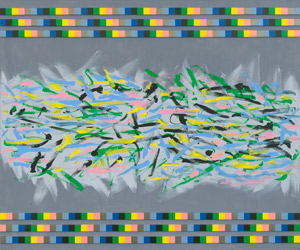To pick up from last time on fall New York art fairs, remember when the Armory Show had an entire pier for modern art? It was not all that long ago.
Remember the days before such hoary institutions as the Frick, the Morgan Library, and the Met committed themselves to contemporary artists, not always in deep context? The past is alive and well where you might least suspect it, the Independent. The fair I cherish for its classy but cutting-edge galleries takes a reassuring step back. Now held twice a year, it becomes for September the Independent 20th Century.
Right off the entrance, it has a window onto that century with Mildred Thompson and her Window Paintings (with Galerie Lelong), with crazy loose verticals. Alice Baber (with Luxembourg & Co.) is just as hungry for abstraction with the stains of her Color Hunger, as is Norman Zammitt (with Karma) in glowing horizontals. Regina Bogat (with Zürcher) mixes things up in shaped canvas and the relief elements of wood strips and coiled blue cord. As here, many are unfamiliar, and many (no coincidence) are women. You can safely ignore Alexander Calder and Pablo Picasso (with Perrotin) or commissioned portraits by Andy Warhol (with Vito Schnabel), although experiments in photography by Sigmar Polke (with Sies + Höke) may come as a surprise. There too much is more to know.
This really was an independent century—and a diverse one. As Dat So La Lee, Louisa Keyser (with Donald Ellis) drew on Native American tradition for her baskets, while others bring folk styles to modern life, like Dindga McCannon (with Fridman) and Winfred Rembert (with James Barron) in Harlem. Ceramic busts by Myrtle Williams (with Salon 94) shine boldly and in black. Marie Laurencin (with Nahmad Contemporary), who exhibited at the original Armory Show, could sum up an alternative history of the century all by herself. I may have my doubts about Jack Youngerman (with Hervé Bize), but he did have his studio on South Street, just a few blocks north by the former seaport, like Agnes Martin and Ellsworth Kelly. You may have your doubts about Modernism itself, but come spring the fair will be back in Tribeca and in the present.
Art has no shortage of works on paper. Museums and galleries alike present them as a window onto the artist’s thoughts or a display of the artist’s hand. So why is Art on Paper once again the bargain basement of the fairs? That is not altogether bad, and it draws crowds all the way to the East River piers to shop around. Like many a bargain, too, it makes up for what it loses in surprise with the reliable and familiar. It is a lost opportunity all the same.
 Could that be why top galleries stand out with the scale of painting? Could that, too, be why the fair itself backs away more and more from prints and drawings (apart from serial prints) to their seeming antithesis, sculpture and installation? It has risen to nine special projects, in the café, the aisles, and even a booth. There the artist displays not just his attachment to handmade or recycled paper, but to selling t-shirts. Another likes Modernism and its welded sculpture so much that he does a fair imitation, in painted cardboard. (If I seem to be avoiding names, consider it a favor to you and the artists.)
Could that be why top galleries stand out with the scale of painting? Could that, too, be why the fair itself backs away more and more from prints and drawings (apart from serial prints) to their seeming antithesis, sculpture and installation? It has risen to nine special projects, in the café, the aisles, and even a booth. There the artist displays not just his attachment to handmade or recycled paper, but to selling t-shirts. Another likes Modernism and its welded sculpture so much that he does a fair imitation, in painted cardboard. (If I seem to be avoiding names, consider it a favor to you and the artists.)
Caryn Martin has discovered that massed monoprints hung loosely enough have the look of plaster in progress. Billy Dufala and Striped Canary (aka Stephen B. Hguyen and Wade Kavanaugh) use plain paper to deliver a cube right out of Minimalism, in white, and an unruly tarp in yellow on the floor. They look impressive at that. Still, in the artist’s book, drawing itself becomes the art object, yet the closest the fair comes is the bookstore. The most cutting project of all, by Tariqa Waters, peddling everything from a freed man’s (or Freedmans) funeral to a naked girl on the roof of a car, takes the shape of yard signs. The yard sale is on—and I wrap up next time with Photofairs New York and the Armory Show.
Read more, now in a feature-length article on this site.
